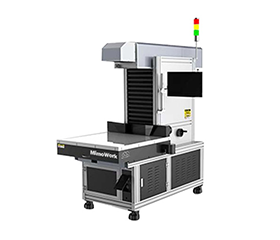Laser Cutting Heat Transfer Vinyl
Laser cutting heat transfer film (also called laser engraving heat transfer vinyl) is a popular method in the apparel and advertising industry.
Due to the contactless processing and precise engraving, you can get excellent HTV with a clean and accurate edge.
With the support of FlyGalvo laser head, the heat transfer laser cutting and marking speed will be doubled which is profitable for production efficiency and output.
What is Heat Transfer Vinyl & How to Cut?

In general, the transfer printing film utilizes dot printing (with a resolution of up to 300dpi). The film contains a design pattern with multiple layers and vibrant hues, which is pre-printed on its surface. The heat press machine becomes excessively hot and applies pressure to affix the printed film onto the surface of the product using a hot stamping head. Heat transfer technology is incredibly replicable and capable of meeting the demands of designers, thus making it appropriate for large-scale production.
The transfer film for heat is commonly made up of 3-5 layers, which consist of a base layer, protective layer, printing layer, adhesive layer, and hot melt adhesive powder layer. The film's structure may vary depending on its intended use. Heat transfer vinyl film is primarily utilized in industries such as clothing, advertising, printing, footwear, and bags for the purpose of applying logos, patterns, letters, and numbers using hot stamping. In terms of the material, heat-transfer vinyl can be applied to fabrics such as cotton, polyester, lycra, leather, and more. Laser cutting machines are commonly used to cut PU heat transfer engraving film and for hot stamping in clothing applications. Today, we will discuss this particular process.
Why Laser Engraving Transfer Film?

Clean cutting edge

Easy to tear

Precise & fine cut
✔ Kiss-cut the film without damaging the protective layer (frosted carrier sheet)
✔ The clean cutting edge on elaborate letters
✔ Easy to peel off the waste layer
✔ Flexible Production
Heat Transfer Vinyl Laser Cutter

FlyGalvo130
• Working Area: 1300mm * 1300mm
• Laser Power: 130W
• Working Area: 1000mm * 600mm (Customized)
• Laser Power: 40W/60W/80W/100W
Video Display - How to Laser Cut Heat Transfer Vinyl
(How to avoid burning edges)
Some Tips - Heat Transfer Laser Guide
1. Set laser power lower with a moderate speed
2. Adjust the air blower for cutting assistant
3. Turn on the exhaust fan
Can A Laser Engraver Cut Vinyl?
The swiftest Galvo Laser Engraver designed for Laser Engraving Heat Transfer Vinyl ensures a significant boost in productivity! This laser engraver offers high speed, impeccable cutting precision, and compatibility with various materials.
Whether it's laser cutting heat transfer film, crafting custom decals, and stickers, or working with reflective film, this CO2 galvo laser engraving machine is the perfect match for achieving a flawless kiss-cutting vinyl effect. Experience the remarkable efficiency as the entire laser cutting process for heat transfer vinyl takes only 45 seconds with this upgraded machine, establishing itself as the ultimate boss in vinyl sticker laser cutting.
Common Heat Transfer Film Material
• TPU Film
TPU labels are most often used as garment labels for intimate wear or active wear. This is because this rubbery material is soft enough that it doesn’t dig into the skin. The chemical composition of TPU allows it to handle extreme temperatures, also capable of withstanding high impact.
• PET Film
PET refers to polyethylene terephthalate. The PET film is a thermoplastic polyester that can be laser cut, marked, and engraved with either a 9.3 or 10.6-micron wavelength CO2 laser. The heat-transfer PET Film is always used as a protective layer.

PU Film, PVC Film, Refelctive Membrane, Reflective Film, Heat Trasfer Pyrograph, Iron-on Vinyl, Lettering Film, etc.
Typical Applications: Clothing Accessories Sign, Advertising, Sicker, Decal, Auto Logo, Badge and more.
How to Layer Heat Transfer Film on Apparel
Step 1. Design the pattern
Create your design with CorelDraw or other designing software. Remember to separate the kiss-cut layer and die-cut layer design.
Step 2. Set the parameter
Upload the design file on MimoWork Laser Cutting Software, and set two different power percentages and cutting speeds on the kiss-cut layer and die-cut layer with the recommendation from MimoWork laser technicians. Turn on the air pump for a clean cutting edge then start the laser cutting.
Step 3. Heat Transfer
Use a heat press for transferring the film to textiles. Transfer the film for 17 seconds at 165°C / 329°F. Remove the liner when the material is completely cold.



